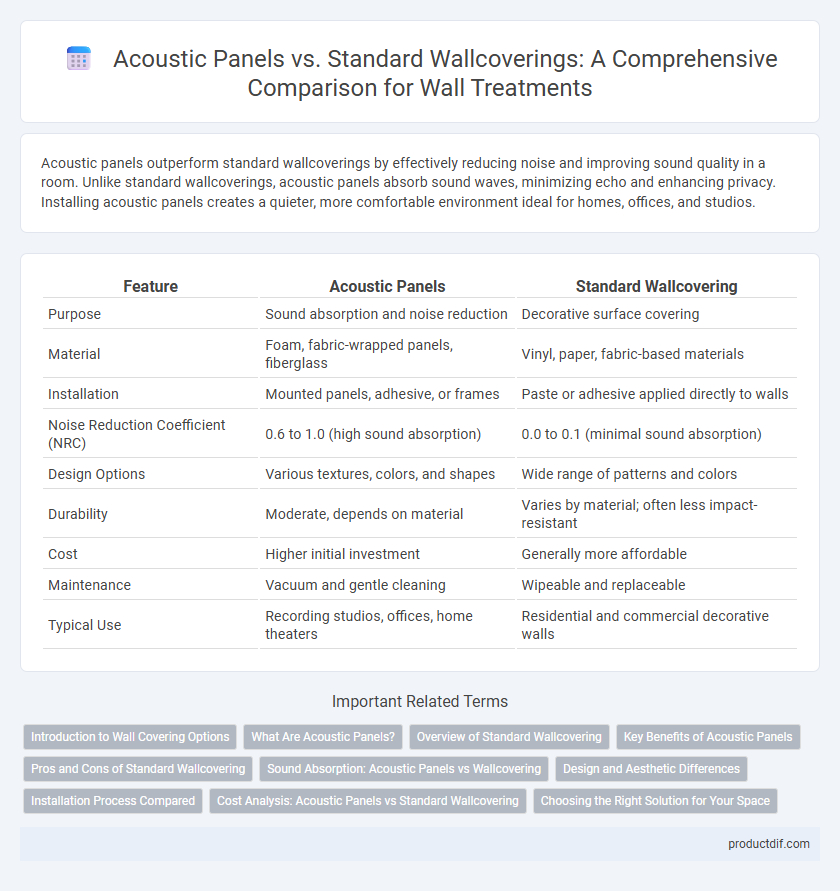Acoustic panels outperform standard wallcoverings by effectively reducing noise and improving sound quality in a room. Unlike standard wallcoverings, acoustic panels absorb sound waves, minimizing echo and enhancing privacy. Installing acoustic panels creates a quieter, more comfortable environment ideal for homes, offices, and studios.
Table of Comparison
| Feature | Acoustic Panels | Standard Wallcovering |
|---|---|---|
| Purpose | Sound absorption and noise reduction | Decorative surface covering |
| Material | Foam, fabric-wrapped panels, fiberglass | Vinyl, paper, fabric-based materials |
| Installation | Mounted panels, adhesive, or frames | Paste or adhesive applied directly to walls |
| Noise Reduction Coefficient (NRC) | 0.6 to 1.0 (high sound absorption) | 0.0 to 0.1 (minimal sound absorption) |
| Design Options | Various textures, colors, and shapes | Wide range of patterns and colors |
| Durability | Moderate, depends on material | Varies by material; often less impact-resistant |
| Cost | Higher initial investment | Generally more affordable |
| Maintenance | Vacuum and gentle cleaning | Wipeable and replaceable |
| Typical Use | Recording studios, offices, home theaters | Residential and commercial decorative walls |
Introduction to Wall Covering Options
Acoustic panels offer specialized sound absorption properties that enhance room acoustics by reducing noise and echo, making them ideal for environments requiring sound control. Standard wall covering options, such as paint, wallpaper, or vinyl, primarily focus on aesthetic appeal and surface protection without providing significant acoustic benefits. Selecting between acoustic panels and standard wall coverings depends on the balance of functional acoustic needs and desired visual design for the space.
What Are Acoustic Panels?
Acoustic panels are specialized wall coverings designed to absorb sound and reduce noise levels within a room, enhancing acoustic quality by minimizing echoes and reverberation. Made from materials such as foam, fabric, or fiberglass, these panels are engineered to improve sound clarity in environments like offices, studios, and home theaters. Unlike standard wallcoverings that focus primarily on aesthetic appeal, acoustic panels combine functionality with design, offering both noise control and visual enhancement.
Overview of Standard Wallcovering
Standard wallcovering primarily serves decorative and protective functions, enhancing interior aesthetics with diverse textures, colors, and patterns. It offers basic durability and is typically easy to clean but lacks significant sound absorption properties compared to acoustic panels. Often made from vinyl, paper, or fabric, standard wallcovering does not address acoustic control needs in spaces requiring noise management.
Key Benefits of Acoustic Panels
Acoustic panels significantly reduce noise pollution by absorbing sound waves, creating a quieter and more comfortable environment compared to standard wallcoverings. They improve speech clarity and reduce echo, making them ideal for offices, theaters, and homes. Unlike traditional wallpaper or paint, acoustic panels enhance privacy and contribute to better sound quality, promoting well-being and productivity.
Pros and Cons of Standard Wallcovering
Standard wallcovering offers a wide variety of styles, textures, and colors, making it a versatile option for enhancing interior aesthetics at a generally lower cost than acoustic panels. However, it provides minimal sound absorption, allowing noise to travel freely, which can reduce privacy and increase echo in rooms. Maintenance is often easier with standard wallcoverings, but they lack the advanced noise reduction properties essential for spaces requiring sound control.
Sound Absorption: Acoustic Panels vs Wallcovering
Acoustic panels significantly outperform standard wallcoverings in sound absorption, effectively reducing echo and reverberation in interior spaces. Unlike regular wallpaper or paint, acoustic panels are engineered with porous materials such as foam or fabric that trap and dissipate sound waves. This makes acoustic panels ideal for environments requiring noise control, such as offices, home theaters, and recording studios.
Design and Aesthetic Differences
Acoustic panels offer a sleek, modern design that enhances sound quality while serving as a stylish focal point in interior spaces, contrasting with standard wallcoverings that primarily provide decorative appeal without sound absorption. These panels come in diverse textures, colors, and patterns, allowing for customizable aesthetics that complement contemporary or minimalist decor. Standard wallcoverings, though visually varied, lack the functional dimension of acoustic modulation and often prioritize pattern continuity over tactile depth.
Installation Process Compared
Acoustic panels often require specialized installation involving mounting brackets or adhesives designed to enhance sound absorption, which can be more time-consuming than applying standard wallcovering. Standard wallcoverings usually involve simple adhesive application directly to a smooth, primed surface, making the process quicker and less complex. The installation of acoustic panels also demands precise placement for optimal sound performance, whereas standard wallcoverings primarily focus on aesthetic alignment.
Cost Analysis: Acoustic Panels vs Standard Wallcovering
Acoustic panels typically cost between $30 and $100 per square foot, reflecting their specialized sound-absorbing materials and installation requirements, while standard wallcovering averages $1 to $10 per square foot, making it more budget-friendly for large areas. The higher upfront investment in acoustic panels is offset by improved sound quality and noise reduction, which is crucial in environments like offices and studios. Standard wallcoverings primarily enhance aesthetics without providing significant acoustic benefits, limiting their functionality despite lower costs.
Choosing the Right Solution for Your Space
Acoustic panels significantly reduce noise levels and improve sound quality, making them ideal for spaces requiring sound control such as offices, theaters, and recording studios. Standard wallcoverings primarily serve decorative purposes and offer limited sound absorption, making them less effective for acoustic management. Selecting the right solution depends on your space's functional needs: prioritize acoustic panels for noise reduction and sound clarity, while standard wallcoverings suit aesthetic enhancements without specialized acoustic benefits.
Acoustic Panels vs Standard Wallcovering Infographic

 productdif.com
productdif.com